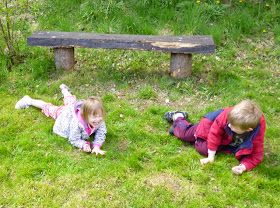Woolsthorpe Manor is a small provincial manor house just south of Grantham, UK. Its claim to fame is that Isaac Newton, the great English scientist, was born here. His grandfather, Robert Newton, had purchased the house and land in 1623. The property came with the title "Lord of the Manor" which immediately raised the family's social status. Grandpa renovated the house and gave it to his son (who was also named Isaac) as a wedding dowry in 1639. Isaac was married to Hannah Ayscough in April 1642. Unfortunately Isaac died in October of 1642, leaving a pregnant widow to manage the estate. His namesake was born prematurely on Christmas Day, and was so small that he could have fit into a quart pot. No one expected him to live. But he did.
Isaac's mother remarried in 1645 and moved to North Witham. She left young Isaac at Woolsthorpe in care of her mother. This act may seem cruel, but the intent probably was to protect the title. He grew up a curious boy, constantly constructing toy mills, sundials, and water clocks. He was fascinated with light and shadows from an early age. Meanwhile, Hannah's second husband died in 1653, leaving three step-siblings who returned with her to Woolsthorpe Manor. Isaac soon went to school in Grantham and moved on at age eighteen to Trinity College in Cambridge.
At college he studied what was expected, the classic Greek scholars. But Newton also read Galileo, Hobbes, Descartes, and Kepler. He began to work on mathematical problems in a new light. After he completed his bachelor's degree in 1665, the plague came to Cambridge. The school was closed and Newton returned to Woolsthorpe for a little over a year. This year is known as the
annus mirabilis, because in the quiet of the country home he was extremely productive: he conducted many experiments with light (including with prisms), he saw the apple fall, he worked on his laws of motion and on his theory of fluxions, which theory would become calculus. He also reflected quite a bit on the scriptures and pursued interests in alchemy.
He returned to Cambridge in 1667 and had a notable career. He returned to Woolsthorpe in 1679 to take care of his mother during her last illness. After her funeral he went back to Cambridge, and eventually to London. He died 20 March 1727 and was buried in Westminster Abbey.
The manor house still looks much as it did in Newton's day. The western exterior (the front of the house) only had a small coat of arms added, commemorating Newton's birth here.
 |
| Woolsthorpe Manor |
 |
| Newton Family Coat of Arms |
 |
| Back of the house |
The interior of the building is quite interesting but photography is not allowed. None of the original furniture is extant and the
National Trust has borrowed period furniture so the house would look as it did in Newton's day. Since they don't own the furniture, they cannot allow photography! In one of the rooms, the fireplace had a small box in the wall next to it. The box was used for storing books, maybe to protect them from damp? The kitchen was quite extensive. Since the home was part of a sheep farm, they would have had to feed many workers in addition to the family.
The estate still has several buildings which have been put to various uses. One barn is now an activity room, with science experiments for the children to do and a short film about Newton's life, especially his time at Woolsthorpe.
 |
| J builds a helicopter and plays with magnets |
Another barn has the tea shop and a science discovery centre with even more exhibits. These included an air hockey table to demonstrate Newton's laws of motion and several colored lights that can be combined to make white light, much like Newton's experiments with prisms.
 |
| Apple air hockey |
 |
| Green+blue+red=... |
 |
| White! |
 |
| L the investigator |
Up in the loft of the barn (where not everyone went) were displays on Newton's interest in alchemy (like changing base metals into valuable ones (i.e. lead into gold)); his attempts to decode the Old Testament to understand the secrets of reality; his work at the mint trying to thwart counterfeiters. His interests weren't always what we'd think of as purely "scientific" though he did use his methodical approach in these areas.
Outside the house we saw what is presumed to be the apple tree, though from all research it's pretty clear the apple didn't actually fall on his head. It merely fell when he was in a contemplative mood and it started him wondering why it fell straight towards the center of the earth rather than some other random direction.
 |
| Apple tree |
J and L tried to conduct their own gravity experiments with a nearby bench.
 |
| Will we fall straight to the ground? |
 |
| Yes, gravity works well here. |
 |
| Is the experiment repeatable? |
 |
| Maybe it's too repeatable! |
We also saw the "wool" part of Woolsthorpe Manor.
 |
| Sheep like the ones from Newton's day |
The back garden of the house also had a human sundial installed by a group of school children.
 |
| Human sundial (sans humans) |
 |
| Sundial instructions |
We enjoyed our visit to the manor and learning more about Isaac Newton, Britain's greatest scientist.
















I'd love to use your Coat of Arms photo in a paper I'm writing currently...do you mind if I use it?
ReplyDeleteYes, feel free to use the picture of Newton's coat of arms in your paper! If you want a higher res copy of the picture let me know.
Delete